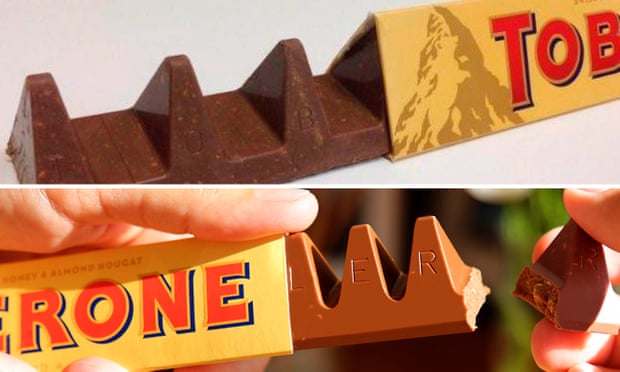Firms use stealth tactics to offset rising costs and competition on the high street
More than 200 different consumer products, from toilet roll to chocolate, have shrunk in size as manufacturers and retailers use stealth tactics to offset rising costs and increasing competition on the high street.
According to figures from the Office for National Statistics, as many as 206 products were made smaller between September 2015 and June 2017 – more than double the number that increased in size.
The analysis confirms a trend of “shrinkflation” – when goods are made smaller but still sold at the same price.
The ONS said the frequency of size changes was the same throughout the period analysed, which included the Brexit vote, even though some manufacturers have blamed the Brexit-linked fall in the pound for shrinkflation.

Richard Lim, the chief executive of the consultancy Retail Economics, said Brexit “was the cause of the sharp fall in value of the pound and retailers have to deal with those rising input costs. One of the levers at their disposal, absolutely, is around reducing packet sizes.”
Shrinkflation has become an established trend in Britain as firms eke out greater profits at the expense of consumers or try to keep on top of rising costs. Supermarket price wars have kept profit margins low, encouraging firms to reduce pack sizes to grow revenue.
Households have faced a “lost decade” of weak wage growth since the financial crisis, constraining their ability to spend, while the push by the government for healthier products and lower portion sizes has also increased.
Tim Rycroft, the chief operating officer of the Food and Drink Federation, said: “The majority of food and drink companies are taking a hit on already tight margins in the notoriously competitive UK grocery market.
“In recent years the industry has faced sharp increases in the cost of essential ingredients, packaging and other raw materials used to make food and drink. The falling strength of the pound since June 2016 has added to these massive cost pressures.”
Several high-profile examples have emerged, including Mars shrinking its Maltesers, M&Ms and Minstrels chocolates by up to 15%, while McVitie’s has cut the number of Jaffa Cakes in a packet from 12 to 10.

Tropicana cut the size of its fruit juice cartons and Doritos shrank the weight of the tortilla chips in each packet; both cited foreign exchange rates among the reasons.
Birds Eye cut the number of fish fingers in a packet from 12 to 10, saying at the time: “The cost of many of our raw materials have risen since the EU referendum.”
The makers of Toblerone faced a consumer backlash after it widened the gap between the chocolate bar’s distinctive triangular chunks. Although there was speculation the change was connected to Brexit, the company, Mondelēz International, said it was not related. Last year it reverted the bar to its original shape, but bigger, and with a higher price.
Food and drink products, as well as everyday household items such as toilet rolls, nappies, tissues and washing-up liquid, were the products examined by the ONS where most size changes occur.
Foods with the highest numbers of product size changes included bread and cereals, meat, sugar, jam, syrups, chocolates and confectionery.
According to the Whitehall statisticians, prices tended to remain unchanged when the size of a product was cut – so the price per gram or millilitre rises.
Although the ONS figures did not show a correlation between the referendum result and shrinkflation, economists said manufacturers would take time to respond to the rise in import costs, making it harder to monitor.
Yael Selfin, the chief economist of the accountancy firm KPMG, said: “Some of the producers would’ve hedged their foreign currency and they would have had some stocks as well. You could expect up to nine months of no impact. It could be a gradual thing.”
Regular inflation also accelerated rapidly after the EU referendum. The UK outstripped every other G7 economy, with the highest inflation rate in five years.
The ONS estimated that only between 1% and 2.1% of food products in its sample had shrunk in size. It also only gathered details on the size and weight of about half of the 37,408 food and drink items in collected price data on a monthly basis.

